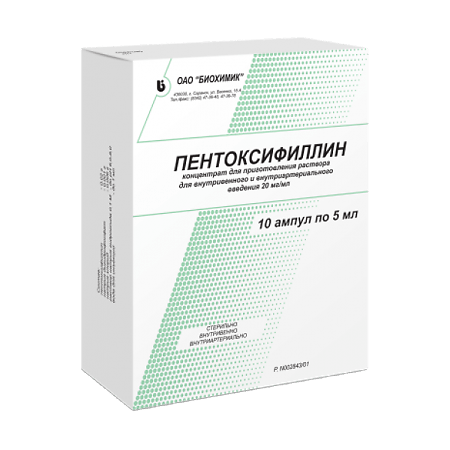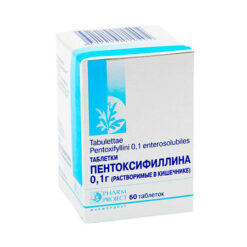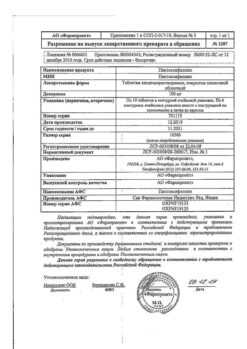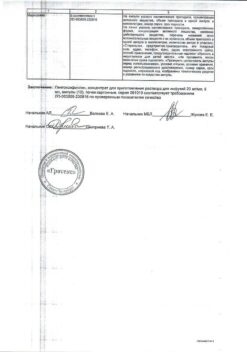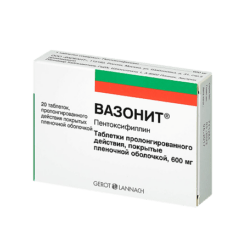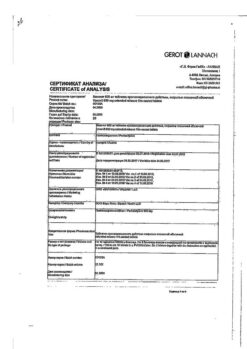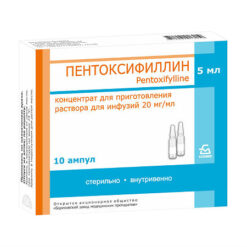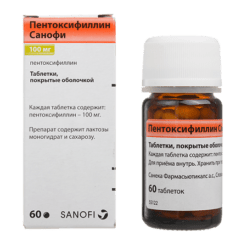No products in the cart.
Pentoxifylline, 20 mg/ml concentrate 5 ml 10 pcs
€1.00
Out of stock
(E-mail when Stock is available)
Description
Microcirculation improving agent, angioprotector, dimethylxanthine derivative. Pentoxifylline reduces blood viscosity, causes platelet disaggregation, increases the elasticity of red blood cells (due to the effect on pathologically altered red blood cell deformability), improves microcirculation and increases the oxygen concentration in tissues. Increases the concentration of cAMP in platelets and ATP in erythrocytes with simultaneous saturation of the energy potential, which in turn leads to vasodilation, reduction of OPPS, increase in stroke volume and minute blood volume without significant change in HR.
Dilating the coronary arteries, it increases oxygen delivery to the myocardium, expanding the pulmonary vessels, improves blood oxygenation. Increases the tone of the respiratory muscles (intercostal muscles and diaphragm).
Injection by injection, along with the above action, leads to increased collateral circulation, increasing the volume of blood flowing through the unit section.
Enhances the concentration of ATP in the brain, favorably influences the bioelectrical activity of the CNS. Improves microcirculation in areas of compromised blood supply.
In cases of occlusive lesions of the peripheral arteries (“intermittent” claudication) it leads to the extension of walking distance, the elimination of cramps of the calf muscles and pain at rest.
After oral administration it is well absorbed from the gastrointestinal tract. Minor metabolism during “first passage” through the liver is noted. It binds to erythrocyte membranes. It undergoes biotransformation first in red blood cells and then in the liver. Some metabolites are active. T1/2 from plasma is 0.4-0.8 hours for unchanged substance, 1-1.6 hours for metabolites. After 24 hours most of the dose is excreted in the urine as metabolites, a smaller part (about 4%) – through the intestine.
The excretion of pentoxifylline is decreased in elderly patients and in liver disease.
Indications
Indications
After oral administration, it is well absorbed from the gastrointestinal tract. There is little “first pass” metabolism through the liver. Binds to red blood cell membranes. It undergoes biotransformation first in erythrocytes, then in the liver. Some metabolites are active. T1/2 from plasma of unchanged substance is 0.4-0.8 hours, metabolites – 1-1.6 hours. After 24 hours, most of the dose is excreted in the urine in the form of metabolites, a smaller part (about 4%) is excreted through the intestines.
The elimination of pentoxifylline is reduced in elderly patients and with liver disease.
Pharmacological effect
Pharmacological effect
An agent that improves microcirculation, angioprotector, and a dimethylxanthine derivative. Pentoxifylline reduces blood viscosity, causes platelet disaggregation, increases the elasticity of red blood cells (due to the effect on the pathologically altered deformability of red blood cells), improves microcirculation and increases the concentration of oxygen in tissues. It increases the concentration of cAMP in platelets and ATP in erythrocytes with simultaneous saturation of energy potential, which in turn leads to vasodilation, a decrease in peripheral resistance, an increase in stroke volume and minute blood volume without a significant change in heart rate.
By dilating the coronary arteries, it increases the delivery of oxygen to the myocardium, dilating the vessels of the lungs, and improves blood oxygenation. Increases the tone of the respiratory muscles (intercostal muscles and diaphragm).
IV administration, along with the above action, leads to increased collateral circulation and an increase in the volume of blood flowing through a sectional unit.
Increases the concentration of ATP in the brain, has a beneficial effect on the bioelectrical activity of the central nervous system. Improves microcirculation in areas of impaired blood supply.
With occlusive lesions of the peripheral arteries (“intermittent” claudication), it leads to an increase in walking distance, elimination of night cramps of the calf muscles and pain at rest.
After oral administration, it is well absorbed from the gastrointestinal tract. There is little “first pass” metabolism through the liver. Binds to red blood cell membranes. It undergoes biotransformation first in erythrocytes, then in the liver. Some metabolites are active. T1/2 from plasma of unchanged substance is 0.4-0.8 hours, metabolites – 1-1.6 hours. After 24 hours, most of the dose is excreted in the urine in the form of metabolites, a smaller part (about 4%) is excreted through the intestines.
The elimination of pentoxifylline is reduced in elderly patients and with liver disease.
Special instructions
Special instructions
Use with caution in case of lability of blood pressure (tendency to arterial hypotension), chronic heart failure, peptic ulcer of the stomach and duodenum (for oral administration), after recent surgery, with liver and/or renal failure, in children and adolescents under 18 years of age (efficacy and safety have not been studied).
In cases of renal dysfunction or severe liver dysfunction, adjustment of the pentoxifylline dosage regimen is required.
During treatment, blood pressure levels should be monitored.
When used simultaneously with antihypertensive drugs, insulin, or oral hypoglycemic drugs, a reduction in the dose of pentoxifylline may be required.
When used simultaneously with anticoagulants, blood clotting parameters should be carefully monitored.
Active ingredient
Active ingredient
Pentoxifylline
Composition
Composition
5 ml of solution contains:
Contraindications
Contraindications
Acute myocardial infarction, porphyria, massive bleeding, hemorrhagic stroke, retinal hemorrhage, pregnancy, lactation. For intravenous administration (optional) – arrhythmias, severe atherosclerosis of the coronary or cerebral arteries, uncontrolled arterial hypotension.
Hypersensitivity to pentoxifylline and other xanthine derivatives.
Side Effects
Side Effects
From the side of the central nervous system: headache, dizziness; anxiety, sleep disorders; convulsions.
Interaction
Interaction
Use with caution in case of lability of blood pressure (tendency to arterial hypotension), chronic heart failure, peptic ulcer of the stomach and duodenum (for oral administration), after recent surgery, with liver and/or renal failure, in children and adolescents under 18 years of age (efficacy and safety have not been studied).
In cases of renal dysfunction or severe liver dysfunction, adjustment of the pentoxifylline dosage regimen is required.
During treatment, blood pressure levels should be monitored.
When used simultaneously with antihypertensive drugs, insulin, or oral hypoglycemic drugs, a reduction in the dose of pentoxifylline may be required.
When used simultaneously with anticoagulants, blood clotting parameters should be carefully monitored.
Manufacturer
Manufacturer
Biokhimik JSC, Russia
Additional information
| Manufacturer | Biokhimik JSC, Russia |
|---|---|
| Medication form | solution concentrate |
| Brand | Biokhimik JSC |
Other forms…
Related products
Buy Pentoxifylline, 20 mg/ml concentrate 5 ml 10 pcs with delivery to USA, UK, Europe and over 120 other countries.

